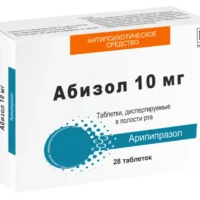Description
Lamictal Tablets 50 mg. №30
Composition
Active ingredient: Lamotrigine 50 mg.
Other ingredients: lactose; magnesium stearate; sodium starch glycolate; FD&C Yellow No. 6.
Mechanism of Action
Lamictal stabilizes electrical activity in the brain by modulating voltage-gated sodium channels, calcium channels, and glutamate release, leading to its anticonvulsant and mood-stabilizing effects.
Pharmacological Properties
Lamictal acts by blocking excessive brain activity that can trigger seizures. Its modulation of various channels and neurotransmitters contributes to its therapeutic effects in epilepsy and bipolar disorder.
Indications for Use
Lamictal tablets are indicated for the treatment of seizures in epilepsy and bipolar disorder.
Contraindications
Do not use Lamictal if you have a known hypersensitivity to lamotrigine or a history of allergy or rash to other antiepileptic drugs.
Side Effects
Common side effects of Lamictal may include dizziness, headache, drowsiness, and nausea. Serious skin rashes, although rare, can occur and require immediate medical attention.
Usage Instructions
Adults: The usual starting dose for epilepsy is 25 mg every other day for two weeks, followed by 25 mg once daily for two weeks. The dose can then be increased by 25-50 mg/day every 1-2 weeks. Take Lamictal as prescribed by your doctor, swallowing the tablets whole with a full glass of water.
Benefits Compared to Analogues
Lamictal is favored for its favorable side effect profile compared to other antiepileptic drugs, with a lower risk of weight gain and sedation. Its efficacy in both epilepsy and bipolar disorder makes it a versatile treatment option.
Suitable Patient Groups
Lamictal is suitable for adults with epilepsy and bipolar disorder. Dosage adjustments may be necessary for specific patient populations such as children and the elderly based on individual health conditions.
Storage and Shelf Life
Store Lamictal in a cool, dry place away from moisture and heat. Check the expiration date on the packaging and do not use the tablets beyond that date.
Packaging Description
Lamictal Tablets 50 mg are available in a package containing 30 tablets. The packaging is designed to protect the tablets from external factors that could affect their stability and efficacy.
Clinical Evidence and Proven Effectiveness
Lamictal has demonstrated efficacy in reducing seizure frequency in epilepsy and stabilizing mood in bipolar disorder patients. Research published in the Journal of Clinical Psychopharmacology supports the long-term effectiveness of Lamictal in bipolar disorder treatment.





